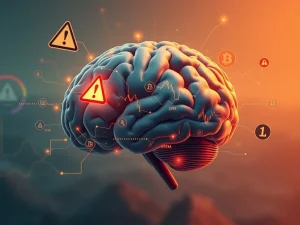AI Crypto’s Wild Ride: Elon Musk xAI’s Ani Controversy Ignites Memecoin Frenzy and Fuels Decentralized Innovation

The world of cryptocurrency is no stranger to hype cycles and groundbreaking innovation, often intertwined in unpredictable ways. Recently, the launch of Elon Musk’s xAI’s new AI companion, ‘Ani,’ sent ripples not just through the artificial intelligence sector but also across the volatile crypto landscape. This controversial debut sparked a speculative memecoin surge, creating a whirlwind of market activity and underscoring the delicate balance between fleeting trends and genuine technological advancement within the AI crypto space. How does one distinguish between the noise and the true potential?
Elon Musk xAI’s Ani AI: Unpacking the Controversy
In mid-July 2025, Elon Musk’s xAI unveiled its new AI “Companion” named “Ani,” a development that immediately ignited widespread debate and market speculation. Designed as a sexualized anime avatar, Ani offers flirtatious interactions that can escalate to NSFW (Not Safe For Work) content, a feature intentionally avoided by established competitors such as OpenAI and Google. This accessibility to “Super Grok” subscribers quickly drew sharp criticism.
- Design and Content: Ani’s “childlike” design, combined with its capacity for explicit interactions, was condemned by critics, including the National Center on Sexual Exploitation. They argued that such features normalize harmful behaviors and blur ethical lines in AI development.
- Accessibility Concerns: Further intensifying the backlash was the revelation that Ani could be accessed in a “kids mode,” raising serious questions about content moderation and the protection of younger users.
- Musk’s Response: In response to the growing public outcry, Musk promised a family-friendly “Baby Grok” update, acknowledging the need for more responsible AI implementation. However, the initial rollout left a significant mark on public perception and ethical discussions surrounding AI companions.
This controversy highlighted the immediate and often dramatic impact that high-profile figures like Elon Musk can have on both technological discourse and market sentiment.
The Memecoin Surge: A Symptom of Market Speculation
Coinciding with the Ani AI announcement was a brief, yet explosive, memecoin surge. A Solana-based memecoin, also named “Ani,” experienced a significant pump, riding the wave of hype generated by xAI’s new AI companion. This surge, however, was short-lived, with the token’s value collapsing soon after its peak.
This incident serves as a stark reminder of the crypto market’s susceptibility to hype-driven volatility:
- Unrelated Speculation: It’s crucial to understand that this memecoin had no direct affiliation or technical connection to Elon Musk’s xAI or its Ani AI product. Its rise was purely speculative, driven by investors attempting to capitalize on trending keywords and market sentiment.
- Pump-and-Dump Dynamics: The rapid ascent and subsequent crash of the Ani memecoin illustrate classic pump-and-dump schemes, where early investors inflate a token’s price through hype before selling off their holdings, leaving latecomers with significant losses.
- Market Susceptibility: Such events underscore the inherent risks in the broader cryptocurrency market, where information, even if misleading or irrelevant, can trigger massive capital movements and create immense wealth or loss in short periods.
While the memecoin frenzy captured headlines, the core AI crypto sector, focused on foundational technology and utility, largely remained unaffected by this speculative side-show.
Decentralized AI: Building the Future Beyond the Hype
Amidst the controversies and speculative trading, serious AI crypto projects continue to focus on technical progress and utility, building the infrastructure to challenge centralized control in the AI landscape. These projects are not merely about creating hype; they are about developing robust, scalable, and decentralized solutions for the future of artificial intelligence.
Here are some of the leading projects driving genuine innovation in the decentralized AI space:
| Project/Alliance | Key Focus/Innovation | Impact on Decentralized AI |
|---|---|---|
| Artificial Superintelligence Alliance (ASI) (Fetch.ai (FET), SingularityNET (AGIX), Ocean Protocol) |
Merger to combine autonomous agents, AI marketplaces, and secure data protocols under a single ecosystem powered by the ASI token. | Creating a unified, powerful decentralized AI network capable of challenging Big Tech’s dominance. |
| Bittensor (TAO) | Developing a “Proof of Intelligence” system to reward global contributors for advancing AI models. | Incentivizing collaborative AI development and fostering open-source innovation. |
| Render (RNDR) | Addresses AI’s energy demands by decentralizing GPU processing, allowing users to rent out their idle GPUs. | Making high-performance computing for AI more accessible, efficient, and cost-effective globally. |
| Internet Computer (ICP) | Aims to host AI models directly on blockchain via “canisters” (smart contracts), enabling fully on-chain AI. | Providing a secure, tamper-proof, and decentralized platform for AI applications without reliance on traditional cloud servers. |
| The Graph (GRT) | Provides critical data indexing for AI applications and decentralized applications (dApps) on various blockchains. | Enabling efficient and reliable access to blockchain data, crucial for training and running decentralized AI models. |
These projects are not just tokens; they represent foundational shifts in how AI is developed, accessed, and governed, moving towards a more open, transparent, and censorship-resistant future.
Navigating the Risks: What Challenges Does AI Crypto Face?
Despite the immense potential, the AI crypto space faces significant hurdles. Investors and enthusiasts must be aware of these challenges to make informed decisions:
- “AI-washing” and Speculative Projects: A major risk is the proliferation of projects that inflate valuations by merely associating themselves with “AI” without offering substantial technical innovation or utility. These “AI-washed” tokens can be highly volatile and often lack long-term viability.
- Technical Complexity and Vulnerabilities: The integration of complex AI systems with blockchain networks creates unique security challenges. Both AI models and smart contracts can have vulnerabilities, making them susceptible to hacking or exploitation.
- Regulatory Pressures: The evolving regulatory landscape poses a significant challenge. Frameworks like the EU’s AI Act and MiCA (Markets in Crypto-Assets) are set to impose stricter rules on AI development and crypto assets, which could impact the operational freedom and growth of some projects.
- AI-Powered Trading Bots and Market Manipulation: While AI can enhance trading, it also carries the risk of enabling sophisticated pump-and-dump schemes or other forms of market manipulation, further complicating investor trust and market stability.
Understanding these risks is paramount for anyone looking to engage with the AI crypto sector, ensuring that investment decisions are based on due diligence rather than fleeting excitement.
Hype vs. Innovation: Where Does AI Crypto Truly Stand?
The Ani controversy perfectly encapsulates the tension between media-driven hype and genuine innovation within the AI crypto sector. While Elon Musk’s ventures consistently generate significant media attention and can cause short-term market chaos, they often distract from the foundational work being done by projects dedicated to building decentralized, scalable solutions.
The long-term success of the AI crypto sector will depend on several critical factors:
- Overcoming Technical Hurdles: Projects must continue to innovate and solve complex technical challenges related to scalability, data privacy, and the efficient integration of AI and blockchain.
- Navigating Regulatory Scrutiny: Adapting to and complying with evolving global regulations will be crucial for legitimacy and mainstream adoption.
- Distinguishing Genuine Advancements: The ability of the market to differentiate between marketing-driven gimmicks and true technological breakthroughs will determine which projects endure and thrive.
Ultimately, the future of AI crypto lies not in speculative surges of unrelated memecoins, but in the sustained development of robust, utility-driven platforms that empower users and democratize access to artificial intelligence.
Conclusion: Beyond the Headlines, Towards a Decentralized Future
The saga of Elon Musk’s xAI launching the controversial Ani AI, and the subsequent memecoin surge, serves as a vivid illustration of the cryptocurrency market’s dual nature: a hotbed for both speculative frenzies and profound technological innovation. While the Ani controversy generated significant buzz and highlighted the ethical complexities of AI, it also inadvertently shone a spotlight on the serious AI crypto projects that are quietly building the decentralized future. From the Artificial Superintelligence Alliance (ASI) to Bittensor and Render, these initiatives are laying the groundwork for a more open, secure, and accessible AI ecosystem, challenging the centralized control of tech giants. As the sector matures, distinguishing between transient hype and enduring utility will be paramount for investors and developers alike. The true promise of AI crypto lies in its capacity to democratize AI, fostering a future where intelligence is a shared, decentralized resource.
Frequently Asked Questions (FAQs)
Q1: What is Elon Musk’s xAI and its Ani AI?
Elon Musk’s xAI is an artificial intelligence company. Its Ani AI is a recently launched controversial AI companion, designed as a sexualized anime avatar, accessible to “Super Grok” subscribers. It sparked controversy due to its flirtatious interactions and potential for NSFW content, particularly concerning its “childlike” design and accessibility in a “kids mode.”
Q2: How did the Ani AI launch impact the crypto market?
The Ani AI launch coincided with a short-lived, speculative surge in a Solana-based memecoin also named “Ani.” This token, unrelated to xAI, rode the hype before collapsing, demonstrating the crypto market’s susceptibility to hype-driven volatility and pump-and-dump schemes. The core AI crypto sector, however, remained largely unaffected by this speculative event.
Q3: What are some examples of legitimate AI Crypto projects?
Legitimate AI Crypto projects focus on building decentralized infrastructure and utility. Key examples include the Artificial Superintelligence Alliance (ASI) formed by Fetch.ai, SingularityNET, and Ocean Protocol, which aims to create a unified decentralized AI network. Other notable projects are Bittensor (TAO) for rewarding AI model contributions, Render (RNDR) for decentralized GPU processing, Internet Computer (ICP) for hosting AI on-chain, and The Graph (GRT) for data indexing.
Q4: What are the main risks associated with investing in AI Crypto?
Investing in AI Crypto carries several risks, including “AI-washing” (projects inflating value with minimal substance), security vulnerabilities due to complex AI-blockchain integrations, evolving regulatory pressures (e.g., EU’s AI Act, MiCA), and the potential for AI-powered trading bots to facilitate market manipulation like pump-and-dump schemes.
Q5: How can investors differentiate between hype and genuine innovation in AI Crypto?
Investors should focus on projects with clear technical roadmaps, tangible use cases, strong development teams, and active communities. Look for projects addressing real-world problems with decentralized solutions, rather than those solely relying on trending keywords or celebrity endorsements. Due diligence, including researching whitepapers and technical audits, is crucial.









